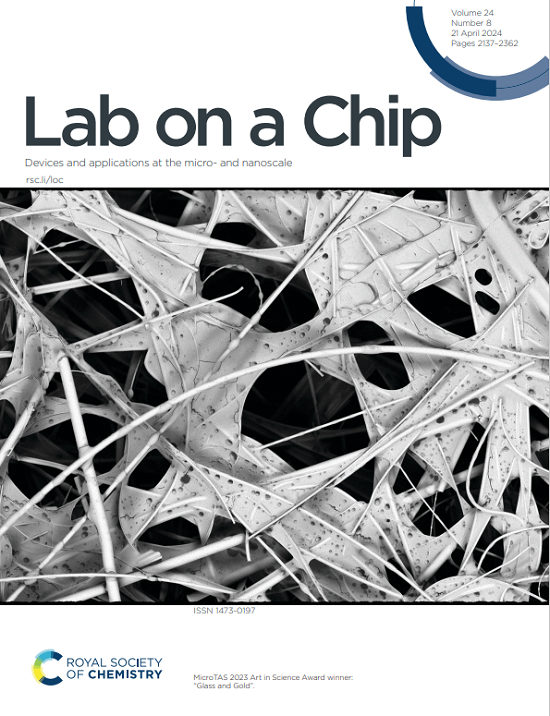采用本征多功能磁性纳米探针对鼠伤寒沙门氏菌进行捕获、富集和信号放大的流线型横向流动免疫分析。
IF 5.4
2区 工程技术
Q1 BIOCHEMICAL RESEARCH METHODS
引用次数: 0
摘要
鼠伤寒沙门氏菌(S. typhimurium)是一种主要的食源性病原体,构成重大的公共卫生风险并导致重大的经济损失。传统的横向流动免疫分析(LFIA)技术用于食源性病原体检测面临局限性,例如筛选配对抗体的过程具有挑战性和昂贵。为了解决这些问题,我们开发了一种创新的无标签LFIA,利用羧基功能化的Fe3O4纳米颗粒来灵敏检测鼠伤寒沙门氏菌。Fe3O4纳米颗粒具有独特的性能,包括磁分离和过氧化物酶样催化活性,可以增强细菌捕获和比色信号放大。本文提出的无标签磁分离LFIA (LFMS-LFIA)利用催化信号扩增对鼠伤寒沙门氏菌的检出限为103 cfu mL-1,灵敏度是单独使用比色信号的10倍。该方法在饮用水、鸡蛋、脱脂牛奶等样品中的鼠伤寒沙门氏菌污染检测中具有广阔的应用前景。通过利用集成了高效结合、磁富集和信号放大能力的探针,这种fe3o4增强的LFIA代表了鼠伤寒沙门氏菌检测的重大进步,具有高灵敏度,无需复杂的设备。本工作为食品安全和环境监测领域的便携式设备现场检测病原体提供了一种成本效益高、灵敏度高的解决方案。本文章由计算机程序翻译,如有差异,请以英文原文为准。
A streamlined lateral flow immunoassay for S. typhimurium using intrinsically multifunctional magnetic nanoprobes for capture, enrichment, and signal amplification.
Salmonella typhimurium (S. typhimurium) is a major foodborne pathogen, posing significant public health risks and leading to substantial economic losses. Traditional lateral flow immunoassay (LFIA) technology for foodborne pathogen detection faces limitations, such as the challenging and costly process of screening paired antibodies. To address these issues, we developed an innovative label-free LFIA utilizing carboxyl-functionalized Fe3O4 nanoparticles for sensitive detection of S. typhimurium. Fe3O4 nanoparticles offer unique properties, including magnetic separation and peroxidase-like catalytic activity, which enhance both bacterial capture and colorimetric signal amplification. The proposed label-free magnetic separation LFIA (LFMS-LFIA) achieved a detection limit of 103 cfu mL-1 for S. typhimurium using catalytic signal amplification, with a sensitivity 10 times greater than that achieved with colorimetric signal alone. This approach demonstrates promising application potential in S. typhimurium contamination detection in samples such as drinking water, eggs, and skim milk. By utilizing probes that integrate efficient binding, magnetic enrichment, and signal amplification capabilities, this Fe3O4-enhanced LFIA represents a major advancement in S. typhimurium detection with high sensitivity and without the need for complex equipment. This work offers a cost-effective and highly sensitive solution in portable devices of food safety and environmental monitoring fields for the on-site detection of pathogens.
求助全文
通过发布文献求助,成功后即可免费获取论文全文。
去求助
来源期刊

Lab on a Chip
工程技术-化学综合
CiteScore
11.10
自引率
8.20%
发文量
434
审稿时长
2.6 months
期刊介绍:
Lab on a Chip is the premiere journal that publishes cutting-edge research in the field of miniaturization. By their very nature, microfluidic/nanofluidic/miniaturized systems are at the intersection of disciplines, spanning fundamental research to high-end application, which is reflected by the broad readership of the journal. Lab on a Chip publishes two types of papers on original research: full-length research papers and communications. Papers should demonstrate innovations, which can come from technical advancements or applications addressing pressing needs in globally important areas. The journal also publishes Comments, Reviews, and Perspectives.
 求助内容:
求助内容: 应助结果提醒方式:
应助结果提醒方式:


